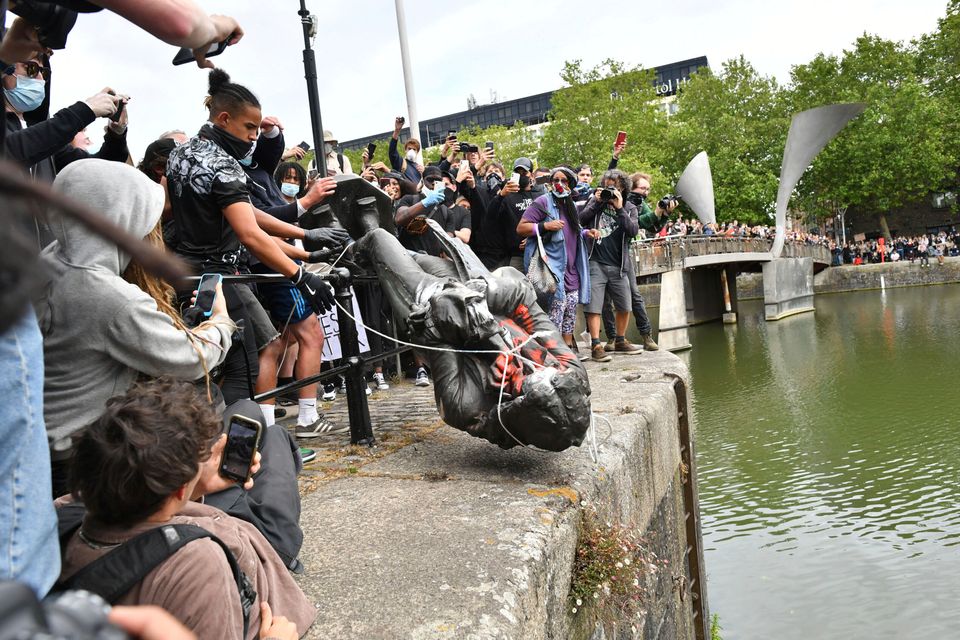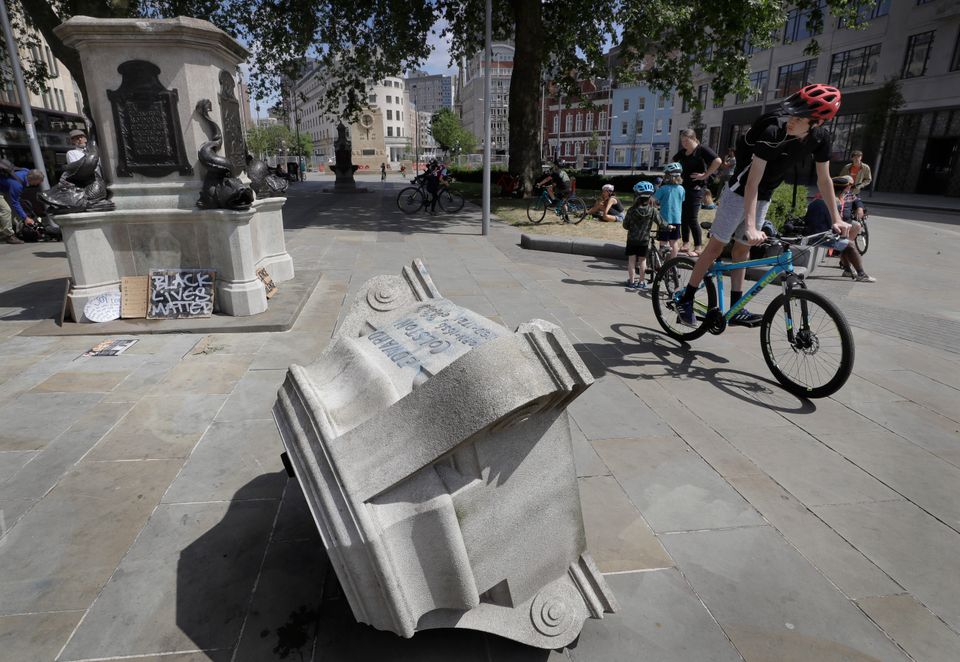The statue of Edward Colston sunk quickly into water it had looked out on for 125 years.
“Goodbye, Mr Colston,” shouted one onlooker, over the cheers of the crowds that had gathered on both sides of the harbour. “Fuck you.”
Colston was the deputy governor of the Royal Africa Company (RAC) from 1680 to 1692, at that time Britain’s only official slaving company. He wasn’t just involved in the slave trade – he ran it.
For many, the sight of his statue dropping to the bottom of the River Avon, at the exact spot his ships would have once left for West Africa, was a fitting end to more than a century of his presence in the city centre.
Throughout his 12 years as the deputy governor of the RAC he was responsible for the transportation of some 84,500 enslaved men, women and children. Almost 20,000 of them did not survive the journey, and were thrown overboard.
“The statue went up in 1895. Most people think it’s 1721, the year of Colston’s death,” said historian Dr Rob Ball, a Bristol-based research fellow at the University of Sussex who specialises in urban riots, slavery and Colston himself.
He is also a member of volunteer-led organisation Countering Colston, which opposes the public celebration of the slave trader.
He continued: “Colston is a kind of cultist construction. He was reinvented in the Victorian period by a bunch of merchants and businessmen who decided they would make him their icon.
“For them, as a philanthropist, he fulfilled two things: ‘moral saint’ and ‘merchant prince’. He did give money away but the question is: where did that money come from?
“He was a leading figure in the organisation of the early stages of the slave trade.”

Despite his legacy, Colston’s name is everywhere in Bristol.
The statue might have been pulled down, but you only need to look up to see the words “Colston Tower” bearing down at you from a high-rise office block. The wide street that sweeps through the centre of the city is called Colston Avenue, and The Colston Arms sits just a short walk away.
Progress towards wiping Colston’s name from some of the city’s most prominent buildings and landmarks has been made in recent years, slowly but determinedly.
Colston Hall, the city’s most prominent concert hall, is undergoing refurbishment. When it reopens, in time for its 150th anniversary, it will do so with a new name.
In 2018, Colston’s Primary School held a three-month consultation and voted to change to Cotham Gardens Primary School, and Bristol’s oldest craft beer pub – known for a time as Colston Yard Pub – is now known as the Bristol Yard Pub. Bristol Cathedral and the Wills Memorial Building, part of the University of Bristol, have also both added prayers and plaques respectively, referencing the horror of Colston’s past.
The statue was perhaps the most tangible symbol of Colston’s legacy in Bristol – yet even with petition after petition and endless debate, nothing could be done about his statue.
For the entirety of its history, the statue has only had one plaque, which read: “Erected by citizens of Bristol as a memorial of one of the most virtuous and wise sons of their city.”
Rather than being funded democratically, as the plaque suggests, it was financed by a relatively small number of wealthy residents who idolised Colston as a philanthropic hero.

Taught as such in schools across the city for decades, it is this image of Colston that still lingers for some who oppose the dismantling of the statue and other rebranding exercises.
Ball explained: “Slavery’s history was obscured for a long time, until the 1920s when a local reverend wrote a book which exposed Colston’s involvement in the slave trade.
“This knowledge has been around for about 100 years, and it’s taken 100 years to actually get somewhere, I think.
“It’s come much more to the surface now, and we can talk about the fact that it makes people feel uncomfortable and as though they’re not part of the city.
“Lots of white residents hate it, but I was talking to a Black friend recently and she told me: ‘All it represents to me, as a Bristolian, is that I’m not part of this city.’
“Unfortunately, there was a real job done on the city in the Victorian period to really push him as the city’s father. They propagated loads of myths and drove a coordinated campaign to build him into the city’s history. They achieved that, and it survived.”

In 2018, a campaign for a second plaque set out to correct the misleading portrayal of Colston’s life and address the “active role” he played in organising the slave trade. By March 2019 it was ready to be affixed to the statue, but was halted after a historian intervened on behalf of the Society of Merchant Venturers – many members of which were historically involved in the slave trade.
The Bristol Post reported at the time that disputes arose over “changing the word ‘trafficked’ to ‘transported’ and maintaining a lengthy dispute about the numbers and ages of the thousands of children who died on board Colston’s ships,” among other purported issues.
In recent days, as Black Lives Matter protests began to spread across the world, the statue received renewed focus. More than 11,000 people signed the petition calling for it to be taken down, hoping this might be the moment it was finally dismantled.
Tearing down a statue is not an unprecedented act in Bristol. In 1812, a group of protesters toppled a statue of King George III, who they perceived to be an anti-democratic oppressor. In 1831, crowds systematically destroyed four prisons and a number of other significant buildings in the city during the Reform Riots.
“Bristol crowds party a lot, but at the same time they know what their targets are,” Ball said. “This [the toppling of Colston’s statue] was no different.
“It was highly symbolic that it was dragged a long way all the way to Pero’s Bridge.”
The bridge – named after Pero Jones who was brought to Bristol in 1785 – is the only place in Bristol named after an enslaved person.
Ball continued: “That, to me, was the crowd saying: ‘We recognise what this means. This has meaning, it isn’t mindless, irrational disorder or a feral youth.’
“It was a very, very conscious decision to make it a symbolic act and to really say something which was: ‘We should not be continuing to celebrate, commemorate or memorialise slave traders.’”
There have long been calls for a museum dedicated to highlighting Bristol’s involvement in slavery, but no such space has ever been approved or opened.

The city’s uncomfortable relationship to its own past has repeatedly been the source of debates and discontent, and groups of residents have occasionally taken matters into their own hands to erect plaques highlighting Bristol’s history.
But there are hopes that the aftermath of the Colston statue’s destruction could lead to a more mainstream discussion about who the city really wants to commemorate.
Ball explained: “It’s not erasing history, because this history is in the history books. Most of the memorials and statues in Bristol were put there by a Merchant elite – it’s not our landscape, it’s somebody else’s.
“It’s so important to study how and why icons were created historically. I sort of think it would serve a function in a museum, but also probably more was done yesterday to put slavery in people’s minds than any number of museums.
“You can always find out about Edward Colston, but if you wanted to find out about the people who actually fought slavery – whether they were enslaved Africans or Bristolians – you had to go to a museum, a library or an archive.
“There’s always this argument that it’s erasing history, but it’s not. It’s opening it up. Now we can say: “OK. Who do we want to celebrate?”